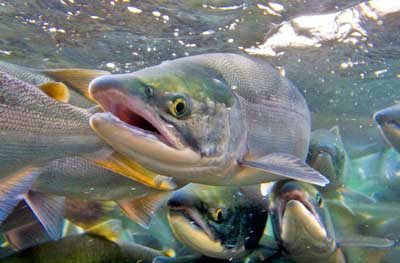By Scott Herning
The Governor’s Salmon Recovery Office recently reported in a Journal article that nearly half of the 15 salmon populations listed under the federal Endangered Species Act are increasing.
What base are they using to measure this increase? Are populations doing better than when listed under the ESA (already a crashed population) or a century ago?
A concept overlooked by fish managers is called “shifting baseline syndrome,” a term coined in 1995 by fisheries biologist Dr. Daniel Pauly.
What this term essentially means is that in order to maximize recovery efforts, biologists must look at the real historical abundance as a baseline. If we base our counts off of salmon in an already degraded state, we will only see an incrementalz
z lowering of standards over time and thus harm real progress for our efforts.
An article entitled ‘Gaining Perspective on What We’ve Lost: The Reliability of Encoded Anecdotes in Historical Ecology’ (tinyurl.com/HistoricalEcology) further explains this concept.
In order to make valiant strides in salmon recovery, we must look back to a “pre-dam” landscape, a time when free flowing, cold, and oxygen-rich rivers were the natural habitat for millions of wild adult salmon and steelhead returning from long ocean journeys back to their native spawning grounds.
Former Secretary of the Interior Bruce Babbit recently stated: “In the space of two decades, dam removal has evolved from a novelty to an accepted means of river restoration.” In that time, federal agencies have spent nearly $10 billion on recovery in the Columbia/Snake River basins, yet according to Taxpayers for Common Sense, “there is little conclusive evidence to quantify the extent of their [recovery actions] effects on returning fish populations.”
Breaching dams shows much promise for salmon recovery in the Pacific Northwest. The removal of the Elwha and Glines Canyon dams in the Olympic National Park were the largest in U.S. history. This shows that Washington state can lead the country in habitat restoration.
It’s been five years since demolition began and researchers are already seeing a “Return of the River” for the first time in over 100 years. In 2014, 432 chinook were counted between the former sites of these dams. It’s amazing how efficiently wild stocks and habitat provide us with a “return on investment” once aged and costly structures are removed.
of the River” for the first time in over 100 years. In 2014, 432 chinook were counted between the former sites of these dams. It’s amazing how efficiently wild stocks and habitat provide us with a “return on investment” once aged and costly structures are removed.
Another group of dams that have been debated for removal for decades are the four lower Snake River dams in southeast Washington. A majority of fish experts agree with breaching these dams, which would open the gateway to 5,500 miles of intact spawning and rearing streams that run through 15 million acres of wilderness.
A revision of the lower Snake River feasibility report shows that these dams are costing Washington taxpayers $160 million dollars per year. After the last dam on the lower Snake was completed in 1975, salmon populations began a journey toward extinction that continues today.
The recently passed Clean Energy Initiative requires large utilities in Washington state to obtain 15 percent of their electricity from new renewable resources, such as solar and wind, by 2020, and to undertake cost-effective energy conservation. Dams disrupt and kill migrating fish, reduce water quality and degrade waterways. Hydropower is not deemed a new renewable resource under this initiative.
Now is the time to breach the four lower Snake River dams to recover wild salmon and steelhead, habitat and wasted taxpayer dollars.
— Editor’s note: Journal graphic artist Scott Herning is a member of the Southern Resident Killer Whale Chinook Salmon Initiative, which advocates removal of the lower Snake River dams.
Learn more about SRKWCSI at www.srkwcsi.org.



